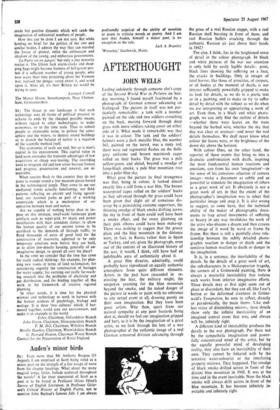Sir: The threat to our landscape is that each technology
uses all forms of political pressure to achieve its ends by the cheapest possible means, without regard to other technologies, to wider economics, or to the time scale. Thus to submit people to intolerable noise, to pollute the atmo- sphere and the waters, to destroy sound buildings or to disturb the balance of nature is a negation of the scientific method itself.
The economies of scale are real, but so is man's capital in his environment. This capital value in land soon overtakes the transient advantages of low acquisition or cheap way-leaving. The overriding need to integrate old and new arises because history Ind progress, preservation and renewal, are in- eeparable.
When tourists flock to this country they do not come to wander round a few museum-pieces buried in the technological jungle. They come to see our mediaeval towns actually functioning; our field- patterns reflecting an ancient and living agricul- ture; our national parks as part of a working countryside which is a masterpiece of co- operation between man and nature.
Are we capable of nothing better than to im- pose on this intimate, small-scale landscape giant artefacts such as super-grid, TV masts and power installations with their attendant clutter; to allow the human quality of our ancient towns to be sacrificed to the demands of through traffic; to flood thousands of acres of good land for the construction of reservoirs, admitted to be only temporary solutions even before they are built, or to allow low-density housing, generally of un- imaginative design, to sprawl all over the place?
In the CPRE we consider that the time has come for really radical thinking: for example, for plan- ning new towns in terms of land reclamation; for considering urgently the construction of barrages for water supply; for carrying out really far-reach- ing research into the problems of electricity and gas distribution, and for binding together all this work in the framework of creative regional planning.
In other words, it is time for the physical sciences and technology to work in harness with the human sciences of psychology, biology and ecology. It is these 'two cultures' which, if har- nessed together, could save our environment, and make it an example to the world.
Esher, Chairman, Oxfordshire Branch John Green, Chairman, Gloucestershire Branch F. M. Hill, Chairman, Wiltshire Branch Neville Hawkes, Chairman, Warwickshire Branch G. Howard Heaton, Chairman Worcs Branch Council for the Preservation of Rural England






























 Previous page
Previous page